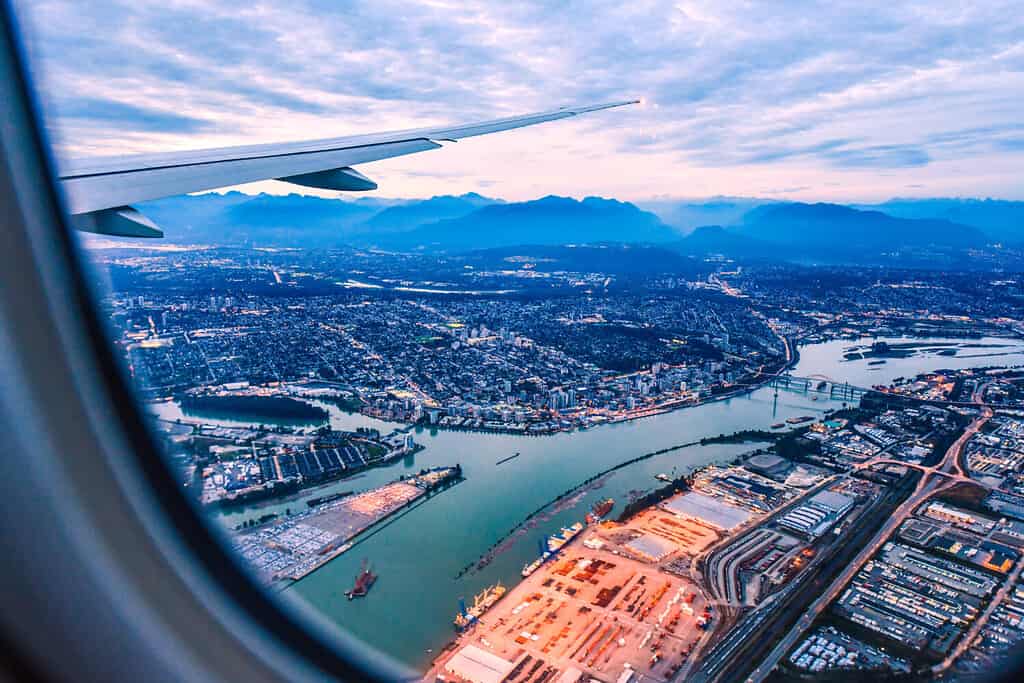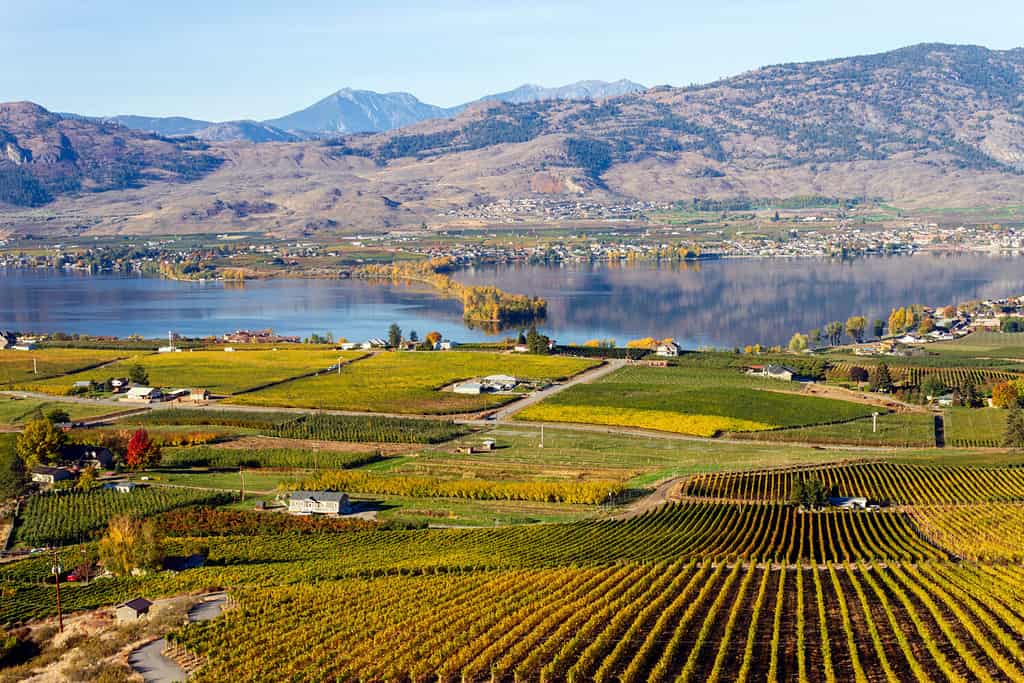British Columbia (BC), a mesmerizing blend of stunning natural landscapes and rich cultural diversity, is a gem nestled on the western coast of North America. Amid this striking tableau, British Columbia’s airports play an integral role, serving as the economic lifelines of the province. After all, British Columbia is an immense province by area. Acting as gateways to British Columbia’s unique attractions, from the rugged wilderness of the north to the cultural vibrancy of the south, these airports are the pulse and rhythm of the province. In this article, we explore the fascinating world of British Columbia’s airports. We highlight their historical significance, passenger volumes, facilities, recent developments, strengths, and areas for improvement.
Beautiful British Columbia’s Airports, Large to Small

Vancouver International Airport is often considered the second best airport in North America after nearby Seattle-Tacoma.
©i viewfinder/Shutterstock.com
Vancouver International Airport: The Pacific Gateway
31 airlines, 75 destinations
Located in Richmond, Vancouver International Airport (YVR) stands as a testament to the evolution of aviation. From its humble beginnings as a floatplane base in 1931, it is now Canada’s second busiest airport. YVR serves approximately 26 million passengers annually. The airport’s journey has seen several milestones. It welcomed its first Boeing 747 in 1971. A decade and a half later, it underwent significant modernization ahead of the Vancouver World Fair of 1986.
YVR offers access to 125 non-stop destinations worldwide. This includes Vancouver Island, a place known for its diverse range of attractions. Thanks to the island’s mild climate, visitors can even go skiing in the nearby mountains, surfing in the bay, and kayaking — all in a single day (for those with unlimited energy).
When it comes to facilities, YVR ensures passenger comfort with an array of dining, shopping, and entertainment options. The airport also offers a unique touch with its YVR Take-Off Fridays, a summer event featuring live entertainment and treats that make layovers enjoyable.
YVR has been a recipient of multiple accolades, including the prestigious Skytrax award for the Best North American Airport for 11 consecutive years. So it’s safe to say that YVR isn’t just British Columbia’s favorite airport, but Canada’s favorite. Fun fact: the cities most flown to from YVR are Los Angeles and Hong Kong.
Despite its impressive record, YVR continually strives for improvement. Navigating the large airport can be overwhelming for first-time visitors. Enhancing its passenger experience with more robust signage and guidance services, i.e., wayfaring, would go a long way.

Vancouver Island is home to many things, such as the provincial capital, the highest concentration of cougars in North America, and much more.
©Mark Skalny/Shutterstock.com
Victoria International Airport: The Island Navigator
5 airlines, 8 destinations
Nestled in the scenic city of Sidney, Victoria International Airport (YYJ) is the second-largest airport in BC. Serving approximately 2 million passengers every year, YYJ offers a cozy, quiet gateway to Vancouver Island’s stunning locales. From mountains to farmlands to beaches, the Comox Valley is an ideal starting point for exploring the Island’s most popular vacation destinations. Travelers can take a deep dive into the area’s rich history, diverse wildlife, and stunning landscapes.
Recently, the airport has seen significant development with the launch of Uber’s rideshare service. This provides travelers with a convenient, safe, and dependable way to get to and from the airport.
Given that the word “international” is in its name, the airport could further improve its services by expanding the flight offerings to international destinations. This would have the added perk of growing a more diverse traveler base.

In addition to its renowned ski resorts, people consider the Okanagan Valley an up-and-coming wine region.
©Nalidsa/Shutterstock.com
Kelowna International Airport: The Okanagan Beacon
8 airlines, 11 destinations
Kelowna International Airport (YLW), located a short distance from the city center, is the gateway to the breathtaking Okanagan Valley. Serving around 2 million passengers per year, YLW stands as a beacon of exceptional customer service and strategic location.
YLW has continually expanded and adapted its infrastructure since its inception in 1947, evolving into a beacon of growth and adaptability. The airport prides itself on its high-quality customer service and cozy layout. Passengers can enjoy a variety of food and shopping options, enhancing the overall travel experience. Despite its smaller size, YLW manages to provide a peaceful and pleasant environment.
However, the airport’s increasing popularity does call for expansion, particularly in terms of its terminal size and capacity. Improvements in the oversized luggage pickup area could also enhance passenger convenience.

For a more boutique experience, consider flying into Comox Airport when visiting Vancouver Island.
©EB Adventure Photography/Shutterstock.com
Comox Airport: The Island Gem
4 airlines, 4 destinations
Though small in size, Comox Airport (YQQ) plays a crucial role in connecting the city of Comox and its surrounding areas. The airport is strategically located amidst the stunning landscapes of Vancouver Island.
YQQ does not compromise functionality and convenience. It offers quick access to the gorgeous regions on Vancouver Island. This make it a preferred choice for travelers seeking to explore the Island’s natural beauty and cultural richness. The airport’s strategic location provides quick access to various regions on Vancouver Island, including popular destinations like Tofino, Parksville, and Cathedral Grove. Despite its size, YQQ boasts facilities like a gift shop, café, and car rentals, adding to its appeal for travelers.
To cater to a broader customer base, YQQ could consider expanding its flight offerings, particularly to international destinations.

Terrace, BC, is known as the Cedar Pole Capital of the World. What’s a cedar pole, you ask? Look out the window at your power line poles.
Northwest Regional Airport Terrace-Kitimat: The Northern Connector
4 airlines, 3 destinations
The Northwest Regional Airport Terrace-Kitimat (YXT) is nestled in the picturesque city of Terrace. It holds great importance in British Columbia’s airport network. Established in 1942, YXT has played a pivotal role in supporting various industries and fostering economic development in the region.
The airport is strategically situated 3 nautical miles south of Terrace, BC. Its location at the intersection of three valleys, Skeena, Kitimat, and Kitsumkalum, makes it an important gateway to the northwest region of British Columbia.
In recent years, the airport has undergone significant renovations, including a new departure terminal in 2018, to accommodate increased traffic from industrial charters in the region. Despite its size, it remains a critical link in British Columbia’s transportation network.
However, the airport could enhance its growth and relevance by diversifying its passenger base.

Though known for hosting sports tournaments, there is plenty of sports adventure to go around in Kamloops.
©Erika Tj/Shutterstock.com
Kamloops Airport: The Tournament Gateway
3 airlines, 3 destinations
Kamloops Airport (YKA) serves as the main gateway to Canada’s Tournament Capital. The city of Kamloops is known for hosting over 100 tournaments each year. As such, it sees a significant influx of athletes and sports enthusiasts. Additionally, it is known for its many beautiful golf courses.
In addition to its sporting reputation, Kamloops is also home to a rich history, vibrant culture, and unique geographical features like an inverted tree line due to limited precipitation. The city is blessed with over 2,000 hours of sunshine annually, making it a year-round destination for tourism.
However, to cater to the diverse needs of its passengers, YKA could consider enhancing some things. This includes its flight connectivity, especially given Kamloops’ reputation as a major sporting and cultural destination.
Conclusion
Airports are more than just points of arrival and departure. They are critical links in the webs of a region’s economy and infrastructure. Each airport in British Columbia, from the bustling corridors of Vancouver International to the quiet charm of Victoria International, plays a unique and vital role.
The true value of an airport lies not just in its size or passenger volume, but in its ability to meet the unique needs of its community. British Columbia’s airports, each in their own way, foster business, connect remote communities, and drive tourism. All of this in a vast province that would otherwise be scarcely connected. Despite how much we all dislike flying, it’s hard to imagine life without these logistical miracles. After all, they make it possible for the average person to cross oceans and traverse mountains.
Thank you for reading! Have some feedback for us? Contact the AZ Animals editorial team.








